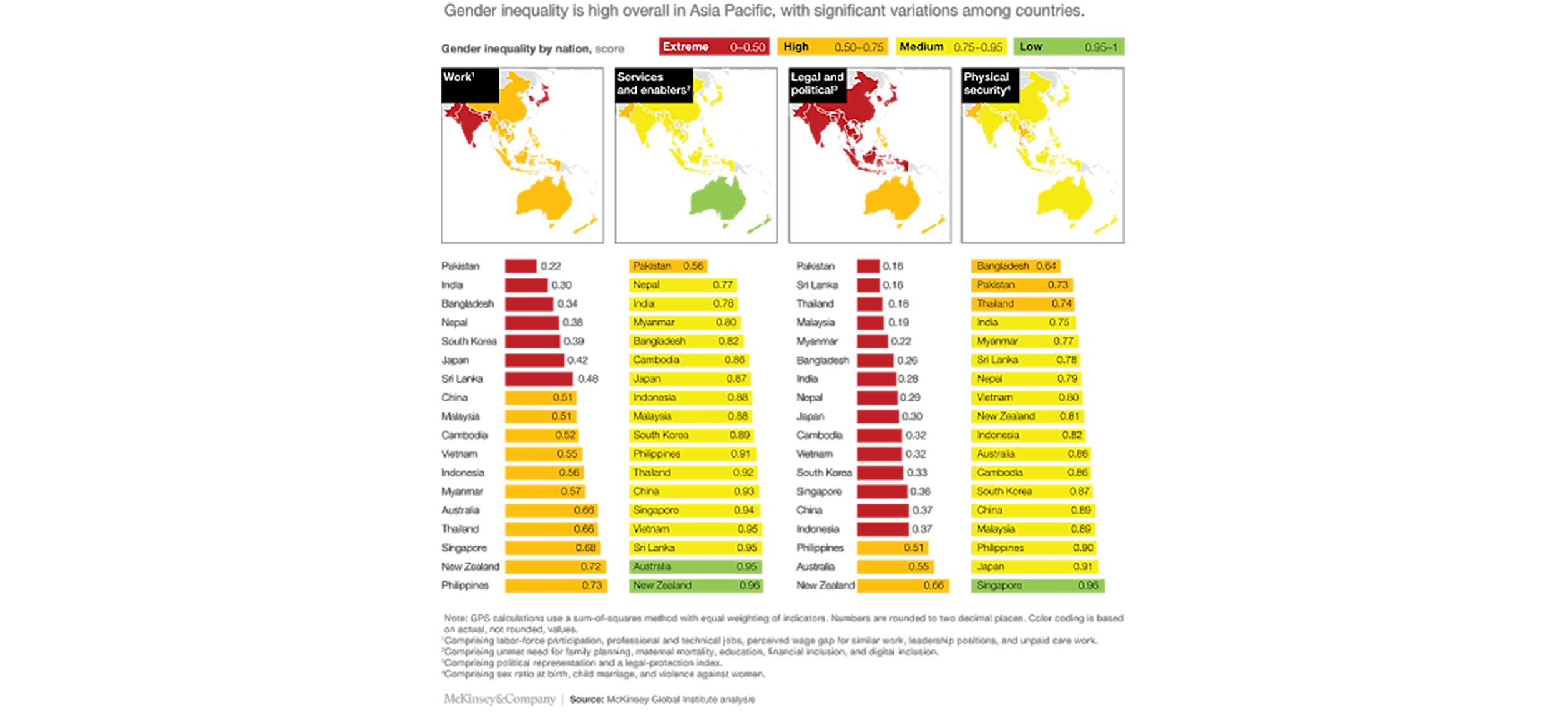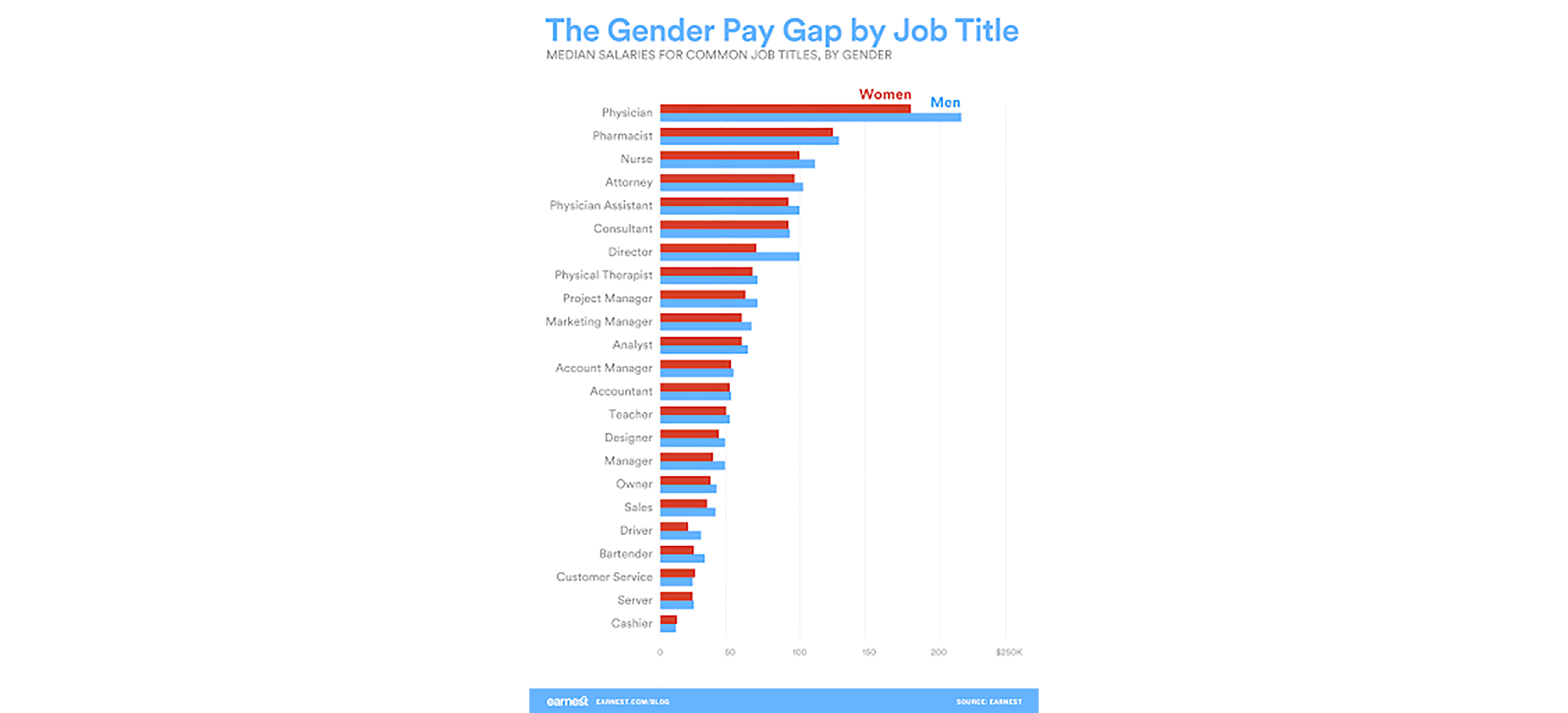
Improving Workplace Gender Equality In ASIA: What Can Government And Companies Do?
5 yearsago 0 Comments 2.3k Views
Asia Pacific today is becoming one of the most innovative regions in the world, driven by strong productivity, investment, technology, and innovation. The dynamic and tech-savvy workforce plays a pivotal role in maintaining and enhancing Asia’s growth. Economic gains, however, still have not translated into equal opportunities for women and men despite many efforts to lift more people out of poverty made by powerful women.
State of workplace gender equality in the Asia Pacific

Gender inequality across Asian Pacific region (Source: MGI)
According to a research on gender equality in the Asia Pacific conducted by the McKinsey Global Institute (MGI) in 2015, there is a strong link between gender equality in work and in society about the role of women – the former cannot be achieved without the latter element. The participation of women in the workforce is constrained due to the uneven share of domestic work, perpetrated by the notion that women have to take care of more household tasks than men do.
MGI uses the Gender Parity Index (GPI) to measure countries’ distance toward parity (set at 1.00). A score of 0.56, which is slightly lower than the global average of 0.61, reveals that gender inequality remains a pressing problem in the Asia Pacific. On equality in work, all nations have much progress to make before attaining parity. With a GPI of 0.55, Vietnam stays in the middle within the region and still has a long way to go – as do most countries in Asia.
Furthermore, although the number of women who are managers or business owners has been on the rise lately, with examples in Vietnam being Ms. Le Diep Kieu Trang (Christy Le) – former GoViet CEO or Ms. Nguyen Thi Phuong Thao – VietJet Air CEO, etc., Asian women are still very much underrepresented in leadership positions. It’s estimated there is only one woman in managerial roles for every four men.
Additionally, as in other parts of the world, women in the Asia Pacific also have to face significant wage gaps in almost, if not every, job position and industry despite similar levels of background and education.

Median salaries for common job titles by gender (Source: Earnest)
What can policymakers and organizations do to improve this situation?
MGI believes fostering workplace gender equality in APAC countries could add $4.5 trillion to their collective annual GDP by 2025, driving economic growth and lifting more people out of poverty. In order to do that, policymakers and organizations should take immediate actions in five key areas, including (1) increase female labor force participation, (2) address the insufficient voice and representation of women in leadership roles, (3) expand access to digital technology, and (4) shift social norms and stereotypes about women’s role in both work and society.
1. Increase female labor force participation
According to MGI, women perform four times more domestic tasks than men, which hinders their freedom to work outside the home. Allowing women to flexibly juggle her career with home responsibilities will give them the opportunity to not only work but also work quality jobs. This can be implemented by sharing housework more equally between women and men, increasing childcare affordability for families, improving household and transport infrastructure, utilizing digital technologies, and promoting paternity leave and flexible schedules.
2. Address the insufficient voice and representation of women in leadership roles
There are a few barriers to women attaining higher-level roles in the company, such as expectations wherein women should prioritize domestic responsibilities over leadership opportunities, a lack of affordable childcare, conscious and unconscious bias in the workplace, and few flexible working options. Companies must mainstream and commit to gender diversity in their operations, offer flexible working options so as to achieve work-life balance, and develop programs that provide women mentorship and skill-building.
3. Expand access to digital technology
Technological innovation is rising at a dramatic rate and is an engine for economic growth. The rise of e-commerce and the online gig economy offers women flexibility in terms of working hours and location, allowing them to balance work with family commitments. As such, more exposure to digital technologies will open more economic doors to women and connect them with larger markets effectively.
Moreover, knowledge of digital technology can help empower women and strengthen their opportunities in the workplace. With industries becoming more and more competitive, companies require their employees to be digitally competent in order to keep up with the rapid changes and bear advantages over their competitors. Therefore, access to digital technologies will allow them to close the digital gaps, provide them the skills and self-confidence to advocate for themselves, and promote their participation in the labor market.
4. Shift social norms and stereotypes about women’s role in both work and society
In many countries, women are often held back due to traditional attitudes and perceptions of gender roles. Women are regarded as family caregivers, which leads to them undertaking most of the household activities and face discrimination in the workplace. In order to ensure that all women have equal access to employment free from discrimination especially based on gender stereotypes, governments, organizations, and individuals in every community combined need to shift such harmful social beliefs and attitudes toward women by using cutting-edge and innovative approaches, organizing campaigns and advertising that address and advance women’s rights in work and society.
Conclusion
While it is true that a lot of progress has been made to remove barriers to women’s participation and advancement in the labor market, the problem of workplace gender equality in Asia Pacific countries still persists. Guaranteeing women’s rights and giving them the opportunity to reach their full potential is critical not only for empowering women but also for attaining higher economic growth. As such, companies, policymakers, all individuals need to take consistent and concerted actions to achieve development at both personal and national levels.
According to McKinsey
——————–
How do you think about this article? Please share it with us via the comment section below.

PRIMUS – TOP MANAGEMENT JOBS ONLY





